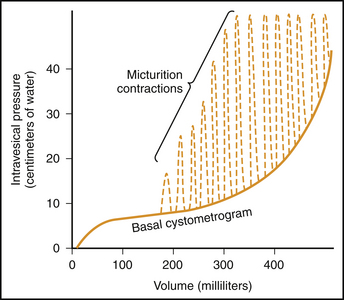23 CASE 23
PATHOPHYSIOLOGY OF KEY SYMPTOMS
When there is little urine in the bladder no pressure is exerted against the bladder wall. An increase in 50 to 300 mL of urine exerts a pressure against the wall, generating a force of 5 to 10 cm H2O. Increases in volume above 300 mL cause pressure to rise; and above 400 mL, intrabladder pressure rises rapidly. Bladder cystometry measures the tension developed within the bladder (Fig. 23-1).

FIGURE 23–1 Normal cystometrogram also showing acute pressure waves (dashed spikes) caused by micturition reflexes.
Only gold members can continue reading. Log In or Register to continue
Stay updated, free articles. Join our Telegram channel

Full access? Get Clinical Tree


